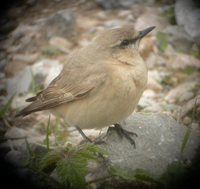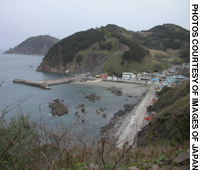This exhausted Isabelline Wheatear, the 'megafind' of the trip to Socheong-do, and only the third-ever recorded sighting in South Korea, is a bird more at home in the steppe and semi-deserts of Mongolia.
Birders' islet of delights
By Mark Brazil | May 19, 2005
SOCHEONG-DO SOJOURNThe last month has been one of considerable atmospheric variety here where I live in Hokkaido, with laggardly spring weather lapsing back to winter sunshine and warmth, then being followed by snow and cold winds. It has been playing havoc with blossoming times, bumblebee emergence and spring bird migration.
All this seems an unfair reward for a returning migrant Black-faced Bunting which finds its home territory still a half-meter deep in snow. It must be more dire still for emerging male Asiatic Chipmunks intent on finding the burrows of still-hibernating females: Where to start with so much snow still on the forest floor?
Readers’ interest
Nonetheless, I was warmed through this odd phase by the number of readers who wrote expressing interest in my March piece about the ancient swan-bone flute, and I was grateful that no one took me to task for the editorial slip that located the famed Galapagos Islands off Chile, not Ecuador (Apologies — Ed).
From swan-bone flutes in March to nesting turtles last month, and now this month, in keeping with the season’s extreme variations, I take a Korean twist for two reasons: One, because of a recent surprise find there; and also because of my own recent experiences.
The discovery of a species previously unknown to science is a high point of any naturalist’s career, and the subject of worldwide news coverage — especially when the discovery is in a well-studied and plentifully peopled locale. So it has been since explorations beneath rocks in South Korea recently led to the identification of a species of salamander that is not just new to that country, but new to the world!
Even more amazing is the fact that the creature in question — which apparently diverged from its aquatic relatives more than 175 million years ago — is a lungless, terrestrial species related only to species found in North and South America, with distant relatives in Italy and Sardinia.
This new find, by high-school teacher Stephen Karsen, of the 40-mm long, nocturnal creature living beneath rocks in a wooded area, made it into the illustrious journal Nature, while Karsen’s name has been immortalized in its generic name of Karsenia koreana, or the Korean Crevice Salamander.
To date, I can’t lay claim to any such startling discovery, although my early May holiday week experience on the tiny island of Socheong-do off the northwest of the Korean Peninsula led to a personal record of sorts.
But where on earth is Socheong-do? (Indeed — Ed.) The new international airport for Seoul, at Incheon, is mercifully close to the Incheon ferry terminal, and it was there that a stalwart trio of Wild Watchers spent more than 24 hours awaiting supposedly scheduled transportation to this remote island. Four hours from Incheon in South Korea, Socheong-do lies within clear view of the North Korean coast, and almost opposite the Shandong Peninsula of eastern China, making it a geographically perfect landfall for tired avian migrants we were heading there to observe.
In the event, we were a tired migrant trio by the time the ferry finally cast off and we embarked on a very different type of excursion during Japan’s Golden Week from those that typically find me checking lagoons, lakes and mountainous areas of eastern Hokkaido for lingering winter visitors and early summer arrivals.
Extreme contrast
This year, by way of extreme contrast, my friends and I undertook to hike the length and breadth of an island that is very hilly and about 4 km long. Our base camp was in a friendly minbak (Korean minshuku; small inn) with whose host we shared, at first, not one word in common — though of course crucial words such as those for rice and beer were soon learned.
We were there for the privilege of being beneath the flight path of thousands of migrants, any number of which we hoped might alight on the island and entertain us with stunning sights before they departed for distant destinations in North Korea or northeast Russia. Sadly, though, it seemed most of these birds of passage understood our expectations as well as we understood our minbak host: Most flitted, at high speed, dodging our raised binoculars; others dived for cover as we approached; some merely sang loudly from the undergrowth and tantalized us with their serenade. Slowly, though, we amassed an increasing list of enjoyable observations.
On Socheong-do, spring had definitely arrived. The almost leafless woods were carpeted in places with the delightful spires of Blue Cordyalis, lending a purplish haze to the forest floor. On our first day after the bad weather that had delayed our arrival abated, the island was knee-deep in flitting Phylloscopus Warblers — a species of which any singleton would have had our Japanese birding comrades drooling with excitement, but we saw them by the barrow load.
Similar exclamations of unbounded excitement over Yellow-browed Warblers and Pallas Leaf Warblers (akin to the Holy Grails of spring migrants for birders in Japan) were soon redundant. We became sated on such fare; delight turned to dismissal, and soon the dread phrase “It’s only another Yellow-browed” passed my lips.
How soon rarity value can be devalued.
We bird-watchers are fickle folk. It’s the novelty, the rareness, that keeps our adrenalin surging. From those hovering sprites of the forest, the lemon-rumped Pallas Leaf Warblers, we soon graduated to the even rarer Dusky Warbler. When that palled, we searched for the rarer Raddes Warbler. It is amazing how grown men can go weak at the knees when a tiny brown bird, with strategically located stripes and streaks, deigns to pop into view however briefly.
Sightings of such rarities in Japan as Chinese Blackbird, Chinese Pond Heron, Black-capped Kingfisher and Richards Pipit came with such rapidity that we soon became convinced there must be a rarity behind every bush. It was hard not to let disappointment gnaw at you whenever there wasn’t.
Such are the demands of a birder, who wants to find a “crippler” (something outrageously rare or exciting) at every turn. But as three strangers in what was for us a strange land, we were unaware of what constituted true rarity value there.
As it turned out, our sightings of everyday, ordinary Japanese White-eyes, and of a white-headed Long-tailed Tit — neither of which would cause me to turn a hair here in Hokkaido — were rarities for Korea.
Tremendous thrill
I am a bunting fan, and to have buntings appear in off the sea even as we picnicked on the sea wall provided a tremendous thrill. A stroll up a tiny stream served up an exciting trio comprising a Little Bunting, a Yellow-browed Bunting and a Tristrams Bunting — any one individual of which would have been the cause of considerable excitement in Japan. On Socheong-do, however, they were but the vanguard for an afternoon arrival of perhaps hundreds of buntings. Any advance on 30 Tristrams Buntings, anyone? There were buntings by the bucketful.
Bad weather had delayed our arrival, and the forecast of further meteorological disturbances led us to leave the island early too. So, on our final morning before the ferry’s scheduled departure, we packed in a last few hurried hours of watching, clutching at straws hoping to snatch glory before our ignominious departure.
A last visit to a small freshwater pool led us to a number of birds coming down to drink, among them a Japanese Yellow Bunting that was the first I had seen for several years. But it was on our way back that we stumbled on our Holy Grail — the megafind of the trip.
Exhausted and crouching there on hard gravel was a migrant well beyond its normal range — a fantastically confiding pale, sand-colored Isabelline Wheatear. This was our crowning glory, a species more at home in the steppe and semi-deserts of Monglia than on a tiny Korean island. It turned out to be only the third recorded sighting in South Korea.
Not only was it a personal first in East Asia, but it gave me a chance to try my hand for the first time at a photographic technique called digiscoping (I hope you like the results).
Flushed with our solitary Isabelline Wheatear success story, we returned elated to Japan — only to be swept up in birder one-upmanship. “An Isabelline?” fellow enthusiasts were soon boasting, “We saw two on Hegura Island” (Where’s that? — Ed). That’s birding!


